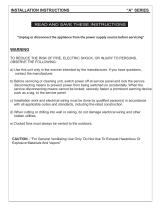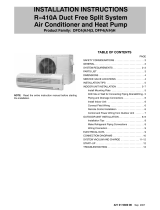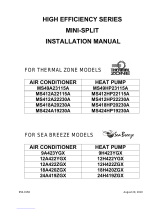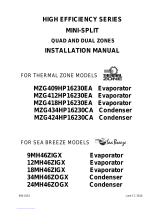Carrier 40MVQ is a duct-free split system designed to provide efficient and reliable heating and cooling for your home. This system consists of an outdoor unit and an indoor unit, connected by refrigerant lines and an electrical cable. The outdoor unit houses the compressor and condenser, while the indoor unit houses the evaporator and blower.
The Carrier 40MVQ is available in a range of sizes to accommodate different room sizes and cooling needs. The system is energy-efficient, with a SEER rating of up to 20.0. This means that the system will operate at a lower cost than traditional HVAC systems, saving you money on your energy bills.
Carrier 40MVQ is a duct-free split system designed to provide efficient and reliable heating and cooling for your home. This system consists of an outdoor unit and an indoor unit, connected by refrigerant lines and an electrical cable. The outdoor unit houses the compressor and condenser, while the indoor unit houses the evaporator and blower.
The Carrier 40MVQ is available in a range of sizes to accommodate different room sizes and cooling needs. The system is energy-efficient, with a SEER rating of up to 20.0. This means that the system will operate at a lower cost than traditional HVAC systems, saving you money on your energy bills.














-
 1
1
-
 2
2
-
 3
3
-
 4
4
-
 5
5
-
 6
6
-
 7
7
-
 8
8
-
 9
9
-
 10
10
-
 11
11
-
 12
12
-
 13
13
-
 14
14
Carrier 40MVQ User manual
- Category
- Split-system air conditioners
- Type
- User manual
Carrier 40MVQ is a duct-free split system designed to provide efficient and reliable heating and cooling for your home. This system consists of an outdoor unit and an indoor unit, connected by refrigerant lines and an electrical cable. The outdoor unit houses the compressor and condenser, while the indoor unit houses the evaporator and blower.
The Carrier 40MVQ is available in a range of sizes to accommodate different room sizes and cooling needs. The system is energy-efficient, with a SEER rating of up to 20.0. This means that the system will operate at a lower cost than traditional HVAC systems, saving you money on your energy bills.
Ask a question and I''ll find the answer in the document
Finding information in a document is now easier with AI
Related papers
-
Carrier 38MVC User manual
-
Carrier 38GXC User manual
-
Carrier MAQB09B1 Installation guide
-
Carrier 40MAQB09B--3 Installation guide
-
Carrier 38MGQ Series Installation Instructions Manual
-
Bryant 38MPRA User manual
-
Bryant 38MHRBQ User manual
-
Carrier 38QRF018300 Installation guide
-
Carrier 40MPHA User manual
Other documents
-
 Reversomatic A SERIESA-8-2 User manual
Reversomatic A SERIESA-8-2 User manual
-
 Climette R-410A Installation guide
Climette R-410A Installation guide
-
Lennox MCB and MWCB Single Zone Mini Split System User manual
-
 Thermal MS49HP23115A Installation guide
Thermal MS49HP23115A Installation guide
-
 International Refrigeration Products 9MH46ZIGX Installation guide
International Refrigeration Products 9MH46ZIGX Installation guide
-
GREE RIO12HP115V1A Rio Installation Manual
-
GREE NEO18HP230V1A Installation guide
-
Bryant 38GRQ Installation guide
-
Bryant 38MAR User manual
-
MRCOOL O-MULTI09HP-WMAH-230 Installation guide

















